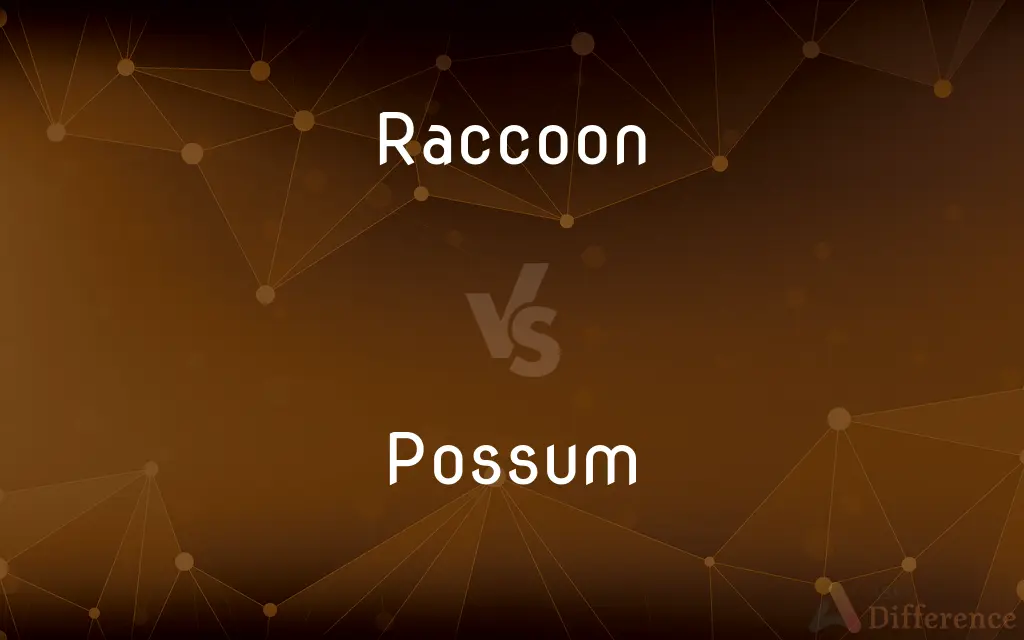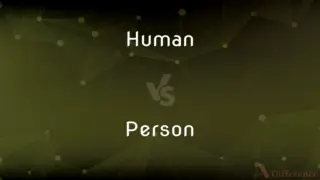Raccoon vs. Possum — What's the Difference?
Edited by Tayyaba Rehman — By Fiza Rafique — Updated on November 2, 2023
Raccoons are nocturnal mammals with a distinct mask-like face marking, while possums are marsupials known for playing dead as defense.

Difference Between Raccoon and Possum
Table of Contents
ADVERTISEMENT
Key Differences
Raccoons are notable for their dexterous front paws and facial mask, which give them a distinctive appearance. They are native to North America and are omnivorous, known for their intelligence and adaptability. Possums, or opossums as referred to in North America, have a pointed face and prehensile tail, and are the only marsupials found in the northern part of the continent, eating a variety of foods from plants to small animals.
While raccoons are adept climbers and often invade urban areas to raid trash cans, they are also important in their natural habitats for their role in seed dispersal and predation. Possums also venture into urban areas but are less agile climbers. They play a critical role in controlling insect and rodent populations due to their varied diet.
Raccoons typically give birth to three to five kits after a gestation period of about 65 days. They are known for their social behavior, sometimes denning together in groups during winter. Possums, on the other hand, give birth to large numbers of tiny offspring which then must make their way into the mother's pouch to continue developing, a distinctive trait of marsupials.
The raccoon’s fur is dense and insulating, often grayish with a bushy, ringed tail, providing camouflage and warmth in various climates. Possums have a less dense and shorter coat, with a large proportion of their body covered with guard hairs which gives them a ragged appearance.
Raccoons have a wide range and diverse habitats, from tropical areas to northern forests, due to their versatile nature in diet and shelter requirements. Possums are more limited to temperate and warmer regions, with their range extending from Canada down to Central America, adjusting to various environments but preferring wooded areas.
ADVERTISEMENT
Comparison Chart
Classification
Mammal (Procyonidae family)
Marsupial (Didelphimorphia order)
Habitat
Varied, including urban areas
Wooded areas, near water
Diet
Omnivorous, highly adaptable
Omnivorous, including carrion
Reproduction
Fewer offspring, no pouch
Many offspring, with pouch
Defensive Behavior
May be aggressive when threatened
Thanatosis
Physical Features
Mask-like facial markings
Prehensile tail
Geographical Range
North America, parts of Central and South America
North and Central America
Tail
Bushy and ringed
Bare, prehensile
Social Behavior
Sometimes social, den in groups
Solitary, except for breeding
Compare with Definitions
Raccoon
They are highly adaptable creatures known for their problem-solving skills.
The raccoon figured out how to open the latch to the trash bin.
Possum
In North America, 'possum' refers to the Virginia opossum, often seen near trash bins.
A possum scavenged through the garbage, looking for food scraps.
Raccoon
Raccoons are intelligent, nocturnal mammals with a distinctive "masked" appearance.
A raccoon rummaged through our picnic basket last night.
Possum
They have a prehensile tail, used for grasping branches and carrying materials.
Our backyard possum carried nesting materials with its tail.
Raccoon
Raccoons have dexterous front paws and are often seen "washing" their food.
I watched a raccoon dipping its food in the creek.
Possum
Possums are solitary animals, often misunderstood due to their appearance and behavior.
Despite its gruff appearance, the possum is generally harmless to humans.
Raccoon
This animal is common in North American folklore and is a symbol of curiosity.
The raccoon, ever the curious bandit, has become a beloved character in stories.
Possum
Possums are immune to certain venomous snake bites, contributing to local ecology.
A possum might just be the best defense against snake infestations.
Raccoon
The raccoon ( or US: (listen), Procyon lotor), sometimes called the common raccoon to distinguish it from other species, is a medium-sized mammal native to North America. It is the largest of the procyonid family, having a body length of 40 to 70 cm (16 to 28 in), and a body weight of 5 to 26 kg (11 to 57 lb).
Possum
A tree-dwelling Australasian marsupial that typically has a prehensile tail.
Raccoon
An omnivorous mammal (Procyon lotor) native to the Americas and introduced elsewhere, having grayish-brown fur, black masklike facial markings, and a black-ringed bushy tail.
Possum
Chiefly Southern US An opossum. See Note at tater.
Raccoon
The fur of this mammal.
Possum
Any of several nocturnal arboreal marsupials of the suborder Phalangeriformes, native to Australia and adjacent islands and introduced elsewhere.
Raccoon
Any of various similar or related animals.
Possum
(US) An opossum, a marsupial of the family Didelphidae of the Americas.
Raccoon
An omnivorous, nocturnal mammal native to North America, typically with a mixture of gray, brown, and black fur, a mask-like marking around the eyes and a striped tail; Procyon lotor.
Possum
Any of the marsupials in several families of the order Diprotodontia of Australia and neighboring islands.
Raccoon
Any mammal of the genus Procyon.
Possum
(intransitive) To play possum; to feign sleep, illness, or death.
Raccoon
Any mammal of the subfamily Procyoninae, a procyonine.
Possum
An opossum.
Raccoon
Any mammal of the family Procyonidae, a procyonid.
Possum
Nocturnal arboreal marsupial having a naked prehensile tail found from southern North America to northern South America
Raccoon
Any mammal superficially resembling a raccoon, such as a raccoon dog.
Possum
Small furry Australian arboreal marsupials having long usually prehensile tails
Raccoon
A North American nocturnal carnivore (Procyon lotor) allied to the bears, but much smaller, and having a long, full tail, banded with black and gray. Its body is gray, varied with black and white. Called also coon, and mapach.
Raccoon
The fur of the North American racoon
Raccoon
An omnivorous nocturnal mammal native to North America and Central America
Raccoon
Raccoons can thrive in diverse environments, from forests to city alleys.
Urban environments have become increasingly populated with raccoons.
Common Curiosities
What is a raccoon?
A raccoon is a nocturnal mammal known for its distinctive black mask and ringed tail.
What do raccoons eat?
Raccoons are omnivores and eat a varied diet including fruits, nuts, insects, and occasionally small animals.
Are raccoons dangerous?
Raccoons can be dangerous if cornered and can carry diseases, but generally, they avoid human contact.
What do possums eat?
Possums are also omnivores and eat fruits, insects, small animals, and sometimes carrion.
Where do raccoons typically live?
Raccoons are adaptable and live in various habitats, including forests, urban areas, and suburbs.
Are possums the same as opossums?
In North America, "possum" usually refers to the opossum. In Australia, "possum" refers to a different group of marsupials.
Can possums hang from their tails?
Young opossums can hang from their tails briefly, but adults are too heavy for this.
Do raccoons hibernate?
Raccoons do not truly hibernate but can sleep for long periods during very cold weather.
Can raccoons be domesticated?
Raccoons are wild animals and generally do not make good pets due to their unpredictable nature.
How do raccoons adapt to urban environments?
Raccoons adapt by scavenging food from trash, using shelters like attics, and becoming nocturnal to avoid humans.
What's the difference between a possum and a raccoon's tail?
A raccoon's tail is bushy with black rings, while a possum's tail is long, hairless, and prehensile.
Are raccoons and possums related?
No, raccoons and possums are not closely related; raccoons are mammals, while possums are marsupials.
Share Your Discovery

Previous Comparison
Human vs. Person
Next Comparison
Stamen vs. PistilAuthor Spotlight
Written by
Fiza RafiqueFiza Rafique is a skilled content writer at AskDifference.com, where she meticulously refines and enhances written pieces. Drawing from her vast editorial expertise, Fiza ensures clarity, accuracy, and precision in every article. Passionate about language, she continually seeks to elevate the quality of content for readers worldwide.
Edited by
Tayyaba RehmanTayyaba Rehman is a distinguished writer, currently serving as a primary contributor to askdifference.com. As a researcher in semantics and etymology, Tayyaba's passion for the complexity of languages and their distinctions has found a perfect home on the platform. Tayyaba delves into the intricacies of language, distinguishing between commonly confused words and phrases, thereby providing clarity for readers worldwide.















































